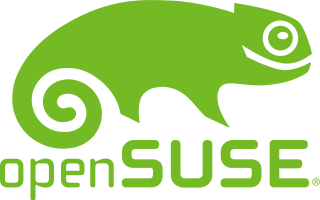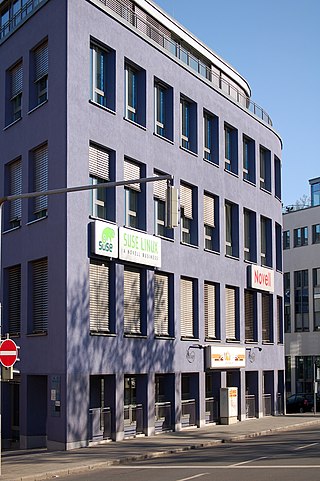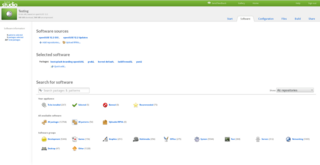In March 2018, SUSE Product Manager Jay Kruemcke wrote in SUSE blog that SUSE Linux Enterprise developers have ported it to Raspberry Pi. [47]
History
SUSE Linux Enterprise Desktop has been developed while SUSE was under the ownership of several different parent companies. SUSE was owned by and conducted business as Novell from SLED's first release as Novell Linux Desktop in 2004 until 2011 when The Attachmate Group purchased Novell and created SUSE as an autonomous subsidiary. Micro Focus in turn purchased The Attachmate Group in 2014 and made SUSE an autonomous business unit, before selling it to EQT AB in 2019. EQT AB is a private equity group that develops new companies before divesting them as independent companies. [48] [49]
- Novell Linux Desktop 9
Novell Linux Desktop (NLD) 9 was originally released November 8, 2004, [50] less than a year after Novell's acquisition of SUSE. There were a number of Service Packs (SP's) released for NLD 9. SP1 was released on February 11, 2005 and contained many updates. After that, SP2 was released on August 9, 2005, containing all the released updates and bugfixes since August 2004. SP3 was released on December 22, 2005.
NLD 9 was based on SUSE Linux 9.1 and offered a more conservative offering of desktop applications for businesses. Its desktop included common end user applications like Mozilla Firefox, OpenOffice.org. NLD also included software developed by Novell and its 2003 acquisition Ximian, such as the Red Carpet software management tool from Ximian and Novell's system management tool ZenWorks. [51]
- SUSE Linux Enterprise Desktop 10
With SLED 10, Novell increased the focus on features for a broader range of corporate users by focusing on meeting the needs for basic office workers, positioning SLED as a competitor to Microsoft Windows. Basic office workers were defined in this context as users who need basic desktop functionality, including an office suite, a collaboration client, a web browser, and instant messaging. Novell attempts to meet these needs by concentrating on making these components very compatible with existing enterprise infrastructure, such as Microsoft Office data files, Microsoft Active Directory, and Microsoft Exchange Server or Novell GroupWise collaboration systems.
It also included the Beagle desktop search tool, [52] similar to Spotlight in Mac OS X v10.4. The Xgl+Compiz support enables a variety of advanced graphical effects in the user interface, such as "application tiling" (similar to Exposé). Other features include making it easier for Linux beginners to connect digital cameras to the computer and play audio files such as MP3s using Helix Banshee. The version of GNOME included this release was highly customized, and debuted the slab application menu on a one panel layout. SLED 10 was originally released June 17, 2006. The last service pack for SLED 10 was Service Pack 4, released April 15, 2011. [53]
- SUSE Linux Enterprise Desktop 11
SLED 11, based on openSUSE 11.1, was released March 24, 2009. It included an upgrade to GNOME and was the first release to ship KDE 4, with version 4.1.3. Several improvements were made to improve Microsoft Active Directory and Microsoft Exchange Server integration, and the Novell OpenOffice.org version was upgraded to version 3.0. SLED continued to include some proprietary components such as Adobe Flash, as well as open-source implementations of closed sourced plugins and runtimes such as Moonlight and Mono. [54]
Four service packs were released for SLED 11, with Service Pack 2 notably bringing BtrFS commercial support to the enterprise Linux market and including the snapper tool to manage BtrFS snapshots. The most current service pack, SP 4, was released July 17, 2015.
- SUSE Linux Enterprise Desktop 12
On October 28, 2014, SUSE (now an independent business unit) released SLED 12 built on openSUSE 13.1. SLED 12 introduced several new technological upgrades, including systemd, GNOME 3, GRUB 2, plymouth, and the in-house built wicked wireless network manager. SLED 12 also included further stability and integration with BtrFS. With the transition to GNOME 3, the GNOME Classic Shell, the vanilla GNOME Shell, and a SLE Classic Shell with a design that more closely mimics the slab layout were included. KDE, the default desktop environment in openSUSE, and support for 32-bit x86 processors were dropped from the enterprise distribution. [55]
SLE 12 Service Pack 1 was the first to be the basis for openSUSE's more conservative Leap series, with openSUSE Leap 42.1 sharing its codebase with SLE 12 SP 1. Leap 42.2 and 42.3 were built from the same codebase as SLE 12 SP 2 and SLE SP 3 respectively. SLED 12's underlying base, SUSE Linux Enterprise Server 12, was the first version of SLE to be offered on the Microsoft Store to be run on the Windows Subsystem for Linux. [56]
- SUSE Linux Enterprise Desktop 15
SLE skipped over versions 13 and 14, realigning the versions of openSUSE Leap and SLE at version 15. SLE 15 was released June 25, 2018 with the same codebase as openSUSE Leap 15.0. SLED 15 included major upgrades to GNOME 3.26, LibreOffice 6.0, GCC 7 and LTS kernel version 4.12. Version 15 also made the Wayland implementation of GNOME the default. SLES and SLED can now also be installed from the same media. SLED 15 offers the same GNOME Desktop options as SLED 12. [57]
SLE 15 SP 1 shares a common codebase with openSUSE Leap 15.1. SLE 15 SP 1 includes improvements to the ability to migrate from openSUSE Leap to SLE, increased 64-bit Arm System on a Chip (SoC) supported processor options, transactional updates, and various other features. [58]
SLE 15 SP 3 features a unified repository with same source code and binary packages with openSUSE Leap 15.3. [59]















